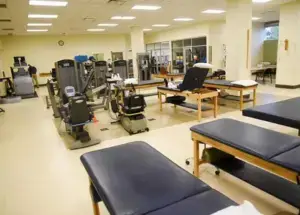The Development of Our Sports Medicine Program
Sports medicine at Meadville Medical Center was developed to provide our local school districts with a complete sports medicine system including the education, prevention, management, treatment, and rehabilitation of injuries, accidents, and overuse conditions among the physically active student athletes within our community. Program development began in the spring of 1997 after several serious injuries occurred within our local high schools. Crawford County Sports Medicine at Meadville Medical Center began providing services to our local school districts in the fall of 1998.
Our sports medicine program has developed into a collaborative program involving Meadville Medical Center and the Conneaut, Crawford Central, PENNCREST, Cranberry, Valley Grove, Jamestown, and Commodore Perry School Districts. The program is also the sports medicine provider for Allegheny College and their athletes.
Sports medicine utilizes various medical professionals including athletic trainers, physical and occupational therapists, orthopedists, primary care physicians, other physician specialties, and neuropsychologists along with sports first aiders, coaches, athletic directors, and principals as the foundation of our sports medicine team to accomplish the program goals.
Sports Medicine Services
- Attendance and coverage at schools for athletic competitions, practices, and tournaments
- Initial recognition and evaluation of injuries which can occur at our schools or during our injury clinics held at One Vernon Place during the school year by appointment only
- Injury rehabilitation, reconditioning, and return to play
- Concussion management
- Injury prevention education
- Priority scheduling of appointments with physicians for further evaluation and testing
- Phone consultations
- Physical and occupational therapy referrals
Frequently Asked Questions
The best principle to follow is PRICE:
- Protection: Protect the area from further injury
- Rest: Avoid irritating the area until pain is diminished
- Ice: Ice the injured area 20 minutes every hour for 48-72 hours after injury
- Compression: Wrap the injury with an ace bandage or other wrap to prevent increased swelling
- Elevate: Raise the injured area above the heart to reduce blood flow and swelling.
Heat can be applied 48 – 72 hours after an injury occurs or when active swelling has stopped (may be more than 72 hours)
Return to activity should occur when pain in the injured area is gone, motion is normal and strength has returned. Time frames for return to play can vary greatly depending on the injury. Proper treatment and rehabilitation can facilitate healing, prevent future reinjury, and decrease time spent out of activity.
The best way to prevent injury is to be in appropriate shape and condition for the activity being performed and to properly warm up and stretch prior to activity participation and to cool down afterwards:
- Warm up: 5 – 10 minutes of light jogging, bicycling, or calisthenics
- Stretching: Stretch the muscles to be used 2 to 3 times each holding 15-20 seconds — don’t bounce or perform a dynamic stretching routine
- Cool down: After activity do 5 – 10 minutes of light jogging or walking followed by light stretching. The cool down followed by stretching helps decrease muscle soreness later.
Sports Medicine Location


